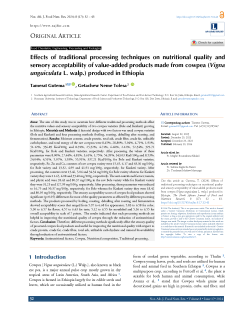Effects of traditional processing techniques on nutritional quality and sensory acceptability of value-added products made from cowpea (<em>Vigna unguiculata</em> L. walp.) produced in Ethiopia
Abstract
Aims: The aim of this study was to ascertain how different traditional processing methods affect the nutritive values and sensory acceptability of two cowpea varieties (Bole and Kenketi) growing in Ethiopia. Materials and Methods: A factorial design with two factors was used: cowpea varieties (Bole and Kanketi) and four processing methods (boiling, roasting, dehulling after roasting, and fermentation). Results: Moisture content, crude protein, total ash, crude fiber, crude fat, utilizable carbohydrate, and total energy of the raw cowpeas were 8.45%, 28.80%, 5.04%, 4.71%, 1.91%, 51.12%, 336.89 Kcal/100g and 8.91%, 25.32%, 4.71%, 6.60%, 2.12%, 52.34%, 329.72 Kcal/100g, for Bole and Kanketi varieties, respectively. After processing the values of these parameters were 8.00%, 27.44%, 4.81%, 3.61%, 1.75%, 54.39%, 343.03 Kcal/100g and 8.53%, 24.04%, 4.51%, 5.07%, 1.93%, 55.91%, 337.21 Kcal/100g, for Bole and Kanketi varieties, respectively. Fe, Zn and Ca, contents of raw cowpea variety were 15.65, 6.17 and 43.36 mg/100g, for Bole variety and 13.32, 4.99 and 41.91 mg/100g, respectively, for Kanketi variety. After processing, the contents were 13.46, 5.04 and 34.34 mg/100g for Bole variety whereas for Kanketi variety they were 11.65, 4.08 and 33.40 mg/100g, respectively. The anti-nutritional factors; tannin, and phytic acid were 28.43 and 80.37 mg/100g in the raw Bole variety while for Kanketi variety they were 31.23 and 127.99 mg/100g, respectively. After processing, these parameters were reduced to 16.75 and 50.37 mg/100g, respectively, for Bole whereas for Kanketi variety they were 18.42 and 80.05 mg/100g, respectively. The sensory acceptability scores of cowpea food products showed significant (p<0.05) differences for most of the quality parameters as affected by different processing methods. The products processed by boiling, roasting, dehulling after roasting and fermentation showed acceptability scores that ranged from 5.97 to 6.68 for appearance, 5.83 to 6.58 for color, 5.30 to 6.57 for flavor, 4.57 to 6.43 for taste, 5.12 to 6.55 for mouthfeel and 5.36 to 6.55 for overall acceptability in scale of 7 points. The results indicated that such processing methods are helpful in improving the nutritional quality of cowpea through the reduction of antinutritional factors. Conclusion: Therefore, different processing methods significantly affect the sensory quality of processed cowpea food products and useful for improving the nutritional quality with respect to crude protein, crude fat, crude fibre, total ash, utilizable carbohydrate and mineral bioavailability through reduction of anti-nutritional factors.
Keywords: Antinutritional factors, Cowpea, Nutritional composition, Traditional processing.
Full text article
Authors
Copyright (c) 2024 Tamerat Gutema, Getachew Neme Tolesa

This work is licensed under a Creative Commons Attribution 4.0 International License.
-
Attribution — You must give appropriate credit, provide a link to the license, and indicate if changes were made. You may do so in any reasonable manner, but not in any way that suggests the licensor endorses you or your use.
-
No additional restrictions — You may not apply legal terms or technological measures that legally restrict others from doing anything the license permits.





